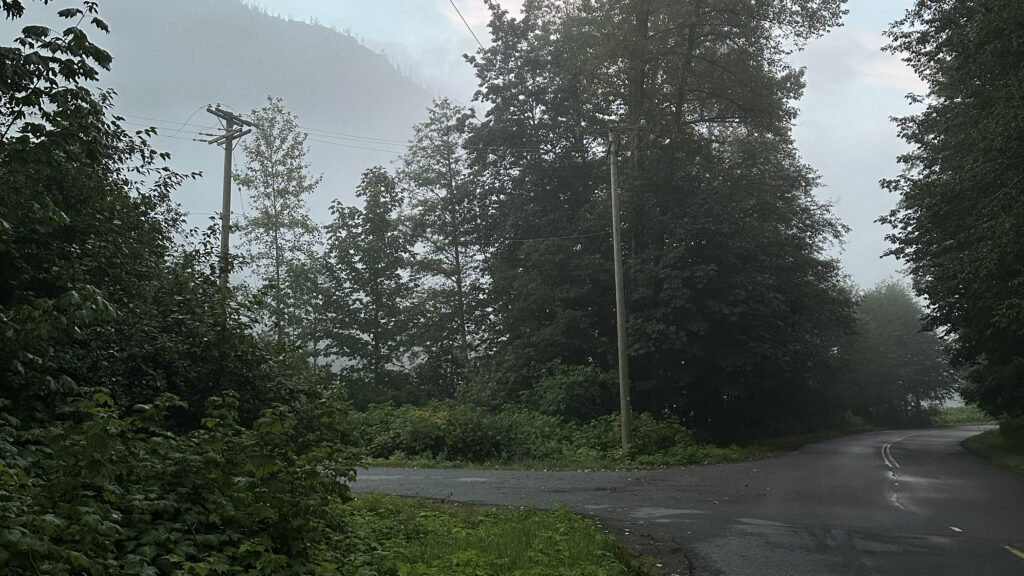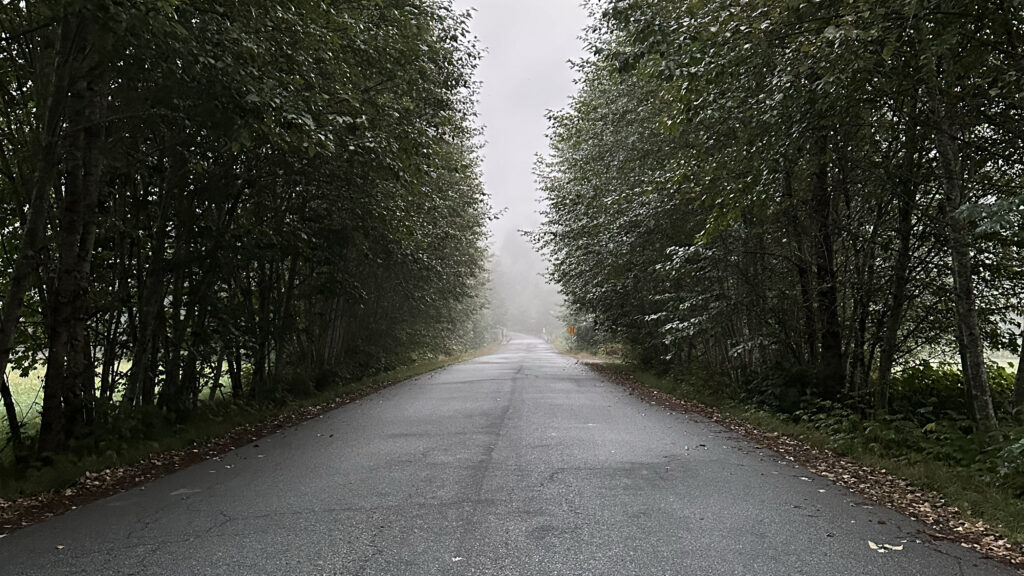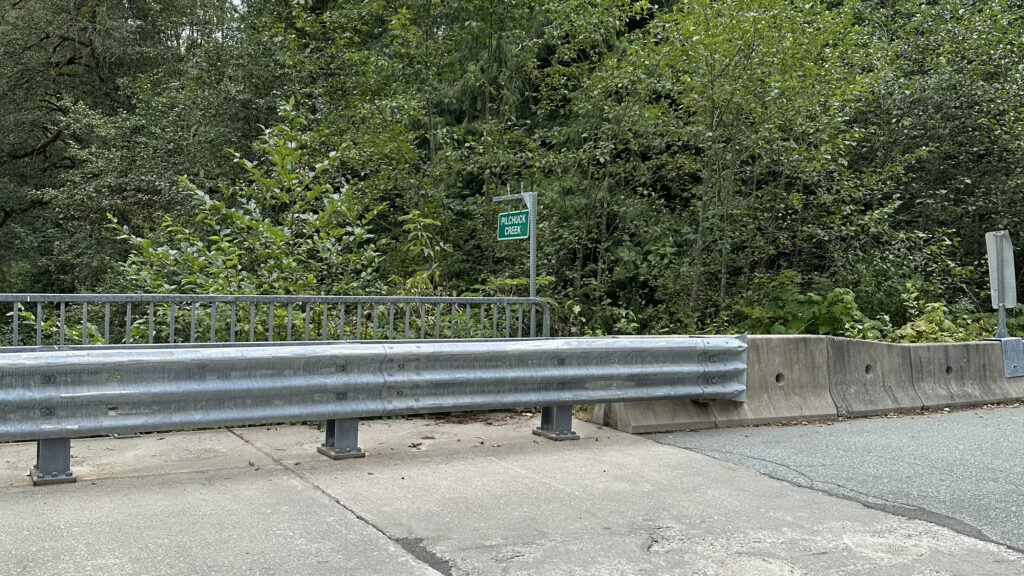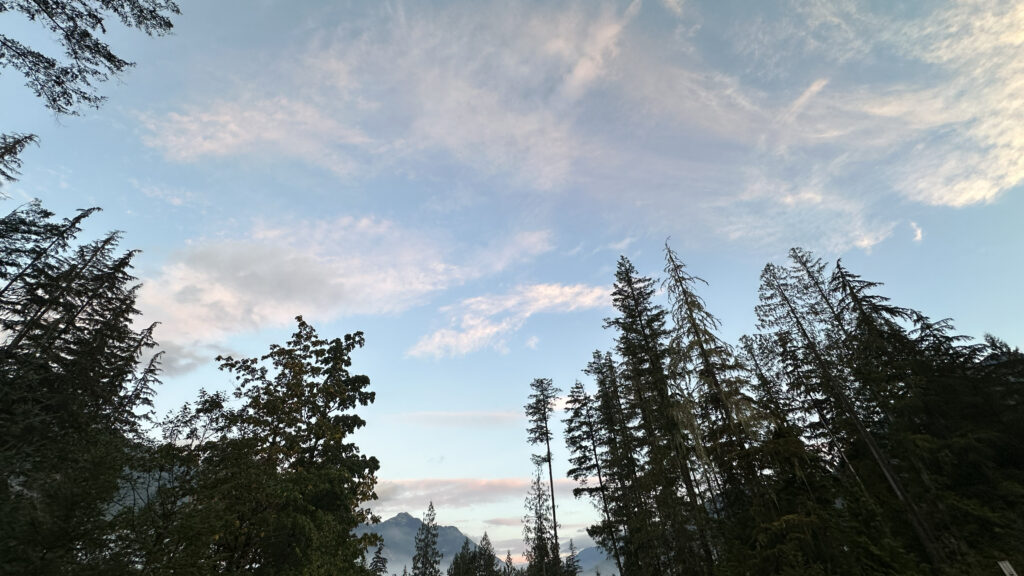6 minute read. Content warning: Sensory descriptions, mentions of tinnitus, and reflections on the complexities of hearing and sound perception and hearing and sighted ableism. Access note: The audio files only include the main descriptive text, and do not voice the bottom three paragraphs of this blog entry.
chatGPT Summary: A detailed and sensory-rich account of a peaceful morning walk through a foggy rural landscape, reflecting on nature, silence, and the subtle sounds and sights encountered along the way.
5AM August 19th, Squamish Nation Territory and Waters – I step out into the fog under a trans-flag coloured sky. The quiet stillness buzzes and rings loudly, as I’ve come to expect this week, accompanied by the absence of traffic and the occasional cock-a-doodle-doo of another early riser. I tiptoe across the gravel, the feel of stone grinding against stone, the memories of its disruptive crunch echoing in my mind. A tranquil tent, installed on a wooden platform within spitting distance of the house, catches my eye and I sneak past. Once on the grass, soft and spongy, my feet bounce, wicking droplets through the mesh of my running shoes like bees in a pollen dance. The fog clings to the farm in gossamer sheets, softening the world into a wet, translucent white.
As I take in the morning, I wonder what scents usually accompany a stroll past the dozing goats, nestled near the wooden cloister but far enough away to ignore my passing. The fog is thick enough that when I reach the end of the rain-hardened driveway, I step onto the paved road and turn right instead of left, diverging from the path I’ve taken for the past seven mornings save one. I walk in the middle of the lane, a two-way highway divided by a broken, high-contrast line. I keep to the left side, ensuring I can easily spot oncoming traffic, aware that my windshield-free visibility is better than theirs.

The trees bow toward each other, forming an arcade into the forest beyond. The road ahead winds dangerously, even without the fog obscuring the air and clinging to the asphalt. It’s a perilous path for a walker, with little to no shoulder, forcing me to watch through the trees for the slightest hint of movement so I can pitch myself into the ditch to avoid speeding vehicles. After seventy steps, I turn left onto a road with a sign that reads “Cloudburst Crescent.” This road, too, is lined with trees, but a few steps forward reveals an iron gate of cold, dark vertical bars, now open to welcome any morning visitors arriving for matins. I wonder if bells are ringing to summon folks to mass, knowing the nuns of the Queen of Peace have taken vows of silence, not deafness. I briefly wonder if the services are also held in silence, but cannot care enough to linger or investigate.

To my right, across from the monastery’s entrance, lies a field of clover and grass dotted with lavender, puffy-topped flowers. Through the roadside trees, the field seems to glow with the diffused light of the morning sun, reflecting off the peach and sage-coloured grass. I pause, for through the sharp static of my tinnitus, I think I hear the percussion of heavy rain. The softly sloping road’s center is dry, a lighter shade of gray like smoke, but its edges are a wet, dense charcoal. Having walked many early mornings on rain-moistened roads, I recognize this drying pattern. Though it may have rained hours earlier, both my skin and the road’s spine confirm that no rain falls now. I sidle closer, pressing my tongue to the roof of my mouth, focusing on the ever-present ringing. As a few choice whistles soften, I again make out the heavy smacking sound from within the trees. I sniff, hoping to catch a scent that might offer a clue, but there is nothing—no movement beyond the soft breath of the forest and the world around me. Later, when tethered once again to electrically generated information, I’ll do some research. For now, I amuse myself with the idea that the forest must be engaged in a private party, generating its own rain with many sloppy kisses and through its foggy, dirty dance.
Passing the meadow and the field beyond the gate, I arrive at a one-lane bridge that crosses Pilchuck creek. There are partitioned sections where pedestrians could walk if the entrances and exits weren’t overgrown with thin, dry grass ending in bushy, itchy explosions of soft seeds and tendrils. On previous walks, I’ve sat on the squat concrete wall, swinging my legs up and over to be contained within the walker’s path, allowing me to lean over the bridge without anxiously monitoring for passing cars. Here, I once took a reference photo for an image I later carved into a stamp from a soft, bubblegum pink square of rubber. This morning, I return to scrutinize the scene and how accurately I captured it in ink before continuing up the road.

Beyond the one-lane bridge, the path angles upward. The grade is steep, bending sharply to the left in a switchback that discourages reckless speed from cars and demands huffing energy from cyclists before doubling its incline on a straighter line up the hill. A neon sign, unnaturally bright, in the silhouette of a small human holding a flag, stands on the rocky shoulder, advising travelers to drive slowly. Beyond it, a dense copse of cedar and alder—cedar branches sloping skyward, adorned with long needle-like fringe, and alder tightly contained with frizzed foliage—hides a slumbering yard scattered with playground equipment.
When I crest the hill, the road pools into the crescent, a signpost stating that the road is no longer public. Stately gates further reinforce that the driveways beyond are privately owned, and I ignore them to stand in the center of the road and spin. The mountains beyond, still framed by the candy pastels of a queer-coloured sky, resemble dark construction paper torn into jagged edges. One mountain is a cold blue, like the taste of a frozen berry, while another looks like soft velvet, evoking the taste of chocolate. The fog hangs low, continuing to cuddle the tree canopies lining the base of this glacial valley. However, the light pale blue of the vast open sky has begun to saturate, and I know the fog will burn off once I descend.

My sensory journal logged and my fingers tingling from typing in the wet morning air, I tuck away my phone and pump my arms as I power down to log my last morning walk along Upper Squamish Road before packing up and heading home.
Dedication:
I wrote this description while thinking of a new friend I made during the Kickstart Disability Arts & Culture Residency and Retreat. I ultimately shared it with the artists at the residency in our group chat, and my friend was able to read it. After gifting me some lovely words, they talked about how they liked how I had used sound to describe my experience. They mentioned they often liked to bring visual imagery into their writing and that it always caused sighted writers, editors, and readers to focus in on that with disbelief and strangeness. Our communication was short during the residency as I was non-verbal throughout and we depended on tactile ASL and a text-to-voice editor, but later I reflected that I sometimes will omit sound description in my work for that very reason. I don’t want to give up the limited space I have been given by hearing majorities by providing even an inch into my lived experience because it often means giving up a mile to assumptions. My hearing ability is also dynamic, and sometimes I remember sounds of things that I can no longer year, I imagine sounds that I do not hear, and I hear sounds that I previously couldn’t (or may not in a different environment).
Technology note:
I continue to test the use of AI within my writing and artistic practice. I used chatGPT to create a summary for this blog as well as content warnings, the reading time estimate, and draft descriptions of the embedded pictures, and Grammarly to assist me in spelling and grammar.
I used Eleven Labs to do an AI clone of my voice to read the text, and chose a background soundtrack from a catalogue of royalty-free music I purchased from Kevin MacLeod. The catalogue came with a spreadsheet that lists instruments, duration, mood, and a note from the composer. I chose a track that was similar in length to the AI voice-track (7 minutes and 5 seconds), and turned the volume to 25% of the voice-over track.
For my own dramatic read, I used audacity and used Octave RTA (an iOS app) to monitor sound, and I played it back and checked its accuracy using the appleOS 14.5 accessibility tools (live caption beta). My dramatic read was a full minute longer than the AI voice clone.
Credits:
Dreams Become Real by Kevin MacLeod (incompetech.com)
Licensed under Creative Commons: By Attribution 3.0 License
http://creativecommons.org/licenses/by/3.0/